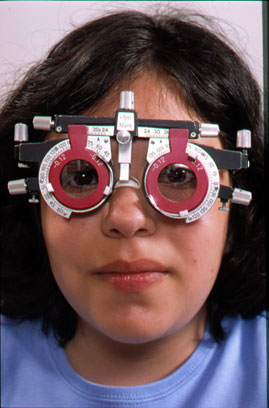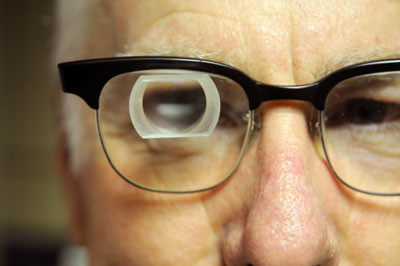When an eye disease prevents clear vision, even with the best pair of glasses, you may need to have a low vision evaluation. The most common eye conditions that lead to low vision include:
- Macular Degeneration
- Diabetes
- Glaucoma
- Optic Atrophy
- Stroke, affecting side vision
- Stargardt’s Disease
- Rod Cone Dystrophy
- Retinitis Pigmentosa
- Plus many many other eye conditions

Your low vision evaluation may include the following:
History – We are interested in knowing how your vision is affecting your daily life activities, such as reading your mail, writing checks, reading labels on products, driving, and watching television to name a few.
Ocular and Medical History - Different eye conditions will affect the vision differently, so it is important to know what eye condition(s) you have
- Muscle Balance Test - to evaluate your eyes ability to work together as a team
- Neurological Test - tests the fraction of the cranial nerves that control eye movements and pupil reflexes
- Visual Field Test - tests the peripheral vision
Refraction – Instead of the standard phoropter instrument that we normally use to measure the power in the eye, we use a trial frame. We can put individual lenses in the frame. You can turn your eye or head slightly in order for you to see the best. It simulates more natural vision and, for many patients, it makes a big difference when we are testing you for glasses.
Biomicroscopy - Evaluation of the front structures of your lashes, lids, cornea, iris, conjunctiva and lens
Ophthalmoscopy – Evaluation of the macula, retina and optic nerve
Tonometry – Measure of the intraocular pressure

Products and Devices
Evaluation of low vision aids, specific for the task, includes:
- Strong reading glasses - Depending on the vision, this is good for reading large print and writing, and viewing pictures
- Hand held magnifiers – Range in power from 2x to 15x , some have lights while others don’t. The power required varies on the size of text one wants to see and their visual acuity
- Stand Magnifiers (px) - Range in power from 2.5x to 15x, these magnifiers lay on the page and are slid across the page. Some have an internal light source which illuminates the text. There are a variety of lights and brightness.
- Monocular Telescopes – Range in power from 1.3x to 10x (and higher, but they are really big and heavy) Used for spotting distant signs and intermediate range up to 18”. Some focus the entire range while others are mainly for distance. (beyond 10’)
- Bioptic telescope (px) – Monocular telescope mounted inside a pair of glasses. These can be used to spot distant signs or objects.
- Electronic Magnifiers – Portable magnifiers that show an enlarged image on a monitor. Multiple styles and sizes are available.
- Closed-Circuit Television – Desk version with computer monitor to show enlarged image of text or pictures. Magnification varies from 3x and up.

Why are magnifiers so small?
Magnification from a lens comes from the curvature of the lens surface and the type of plastic used to make the lens. So, in a weaker magnifier, the radius of curvature is relatively flat, like the section of a beach ball.
You can have a larger diameter lens, but it will not be very strong. The stronger magnifiers require a steeper radius of curvature, similar to a golf ball. Therefore, the lens will have a small diameter. Also, the stronger the lens, the more magnification you get, but the field of view (number of words that you can see at once) gets smaller.
Why are some magnifiers so expensive?
The more expensive magnifiers tend to have better optics. This is most apparent at the edge of the lens, where the letters remain clear. In the lesser quality magnifiers, the distortion at the edge of the lens can limit the useful field of view, decrease the clarity, and therefore decrease the reading speed. This is more significant in the 3x powers magnification and higher. Depending on the patient’s vision, he or she may or may not notice the difference in clarity.
Do I need more light?
Lighting is sometimes more important than the power of the lens. With good lighting, patients will generally see more clearly. This is because the photoreceptor cells in the macula need a lot of light in order to function optimally. A good lamp would need to be held about 12 inches away from the paper. Ideally, the light should come from behind or be overhead and should shine directly on the paper. If you put light in front of you, the light will reflect off the paper like a mirror and create glare, making it difficult to read.









